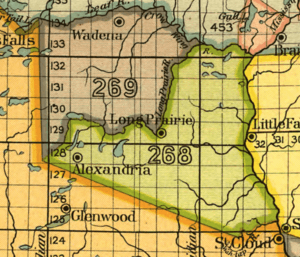Treaty of Fond du Lac facts for kids
The Treaty of Fond du Lac refers to two important agreements signed in Duluth, Minnesota. These treaties were made between the United States government and the Ojibwe (also known as Chippewa) Native American people.
The 1826 Fond du Lac Treaty: Mining Rights
The first Treaty of Fond du Lac was signed on August 5, 1826. It was agreed upon by Lewis Cass and Thomas L. McKenney for the United States. The Ojibwe leaders from the Lake Superior and Mississippi areas also signed it. This treaty was officially recognized on February 7, 1827.
A key part of this treaty was that the Ojibwe Nations gave the United States the right to look for and dig up minerals on Ojibwe lands. These lands were located north of a line set by an earlier agreement called the First Treaty of Prairie du Chien. The treaty also included agreements for the Ojibwe people living near the Saint Mary's River.
The 1847 Fond du Lac Treaty: Land Cession
The second Treaty of Fond du Lac was signed on August 2, 1847. Issac A. Verplank and Henry Mower Rice signed for the United States. Leaders from the Ojibwe of Lake Superior and the Mississippi areas also signed. This treaty became official on April 7, 1848.
This agreement involved the Ojibwe giving up a large piece of land. This land was shaped like a triangle and was located west of the Mississippi River. Its borders were defined by the Prairie du Chien Line, the Mississippi River, the Crow Wing River, and the Long Prairie River.
The Ho-Chunk People and the Treaty Land
Before the 1847 treaty was signed, the Mille Lacs Band of Ojibwe have oral histories that say the Ojibwe and the Ho-Chunk Nation talked. The Ho-Chunk were worried about their safety because they were being moved from their lands as Iowa became a state.
The plan was for the Ho-Chunk to move to the land that the Ojibwe gave up in the 1847 treaties, near the Long Prairie River. However, many Ho-Chunk people did not want to move there. Some went to Wisconsin, and others went to Nebraska. The rest were moved to Minnesota in 1848 and again in 1850.
Life on this new land was hard for the Ho-Chunk. There were often fights between Ojibwe and Dakota groups, and the Ho-Chunk sometimes got caught in the middle. They were not happy with the land. Eventually, in 1855, they were moved again to an area near the Blue Earth River in southern Minnesota.
After the U.S.-Dakota War in 1862, many people in Minnesota did not want the Ho-Chunk Nation to stay in the state, even though the Ho-Chunk had remained neutral during the war. So, the Ho-Chunk later gave up their Minnesota lands to the United States in 1865. They were then moved to South Dakota and later to Nebraska. The land the Ojibwe gave up in 1847 was eventually opened up for white settlers.


